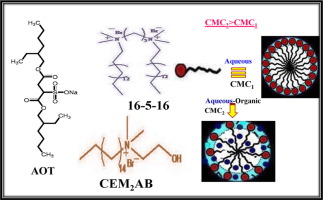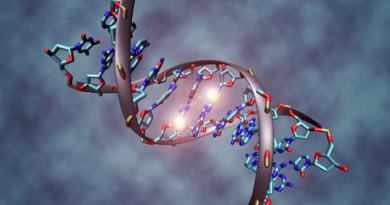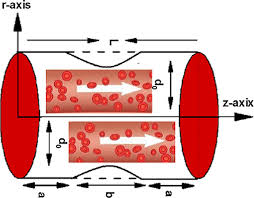Studies on the Solvent Effect of DMSO
Studies on the Solvent Effect of DMSO on the medicinal potential of Hexanoate Ester
Kiranmayee1 and R. T. Singh2
1. Senior Research Scholar, Dept. of Chemistry, V.K.S.University,Ara
2. University Professor of Chemistry and former Dean of the Faculty of Science, V.K.S.University, Ara.
ABSTRACT:
In order to highlight the biochemical and medicinal importance of hexanoate esters, the kinetics of alkali catalysed solvolysis of Propyl Hexanoate Ester, having longer carbon chain was studied in water-DMSO media of varying composition ranging from 30 to 80% of DMSO in the reaction media at different temperatures varying from 20 to 40°C. The rate of the reaction was found to decrease with increasing proportion of the DMSO at all the temperatures. For variation in rate and activation energy of the reaction, it is inferred that effect of change in dielectric constant values and selective solvation of reactants are responsible for depletion in rate while solvation and desolvation of the transition and the initial states respectively are the causes for depletion in the values of iso-composition activation energy of tlie reaction.
From the increasing number of water molecules from 0.364 to 1.748 with increasing temperature of the reaction it is inferred that DMSO changes its mechanistic path from bimolecular to unimolecular.
From the evaluated value of iso-kinetic temperature (283.46) of the reaction, it is concluded that in this reaction media (water-DMSO), there is a weak but appreciably considerable solvent-solute interaction.
Key words: Hexanoate, Solvolysis, Activation parameters, Longer Carbon Chain, Solvent systems, Solvent-solute Interaction, Depletion, Specific solvation, Uni & Bimolecular,Iso-kinetic temperature
INTRODUCTION:
Various researchers1-5 have reported about the solvent effect on the solvolysis of simple esters but the study of the effect of solvent on the biochemical and medicinal activity due to solvation of ester having longer carbon chain has not been paid adequate attention so far. It was thought essential to study the solvent effect on the alkali catalysed solvolysis of the propyl hexanoate ester as it seems fruitful from biochemical as well as medicinal points of views.
Experimental:
The kinetics of alkali catalysed solvolysis of propyl hexanoate was studied in water-DMSO media having varying composition of the reactant media, separately prepared by adding 30 to 80% of DMSO in it. The reaction mixture was prepared such that its strength in terms of ester as well as alkali were kept 0.05 M and 0.1 M respectively. The temperature of the reaction were varied from 20 to 40°C. The reaction was found to follow the second order kinetic equation and the evaluated values of specific rate constants are recorded in Table – I. The evaluated values of Iso-composition activation energy (EC) and Iso-dielectric activation energy (ED) respectively in Table – II and III.
From the slopes of the plots of log k values versus log [H2O] values, the evaluated values of number of water molecules associated with the activated complex have been inserted in Table .- IV. The consolidated values of the thermodynamic activation parameters have been tabulated in Table -V.
Effect of Solvent on Iso-composition Activation Energy (EC or Eexp) :
After making observation of the values of Eexp or EC in Table – II, it is clear that there is depletion in the Eexp values with increase in the concentration of DMSO in the reaction media. The Eexp values decreaes from 115.87 kJ/mole to 71.06 kJ/mole. It has been established that changes in the values of activation energy are obviously noticeable only when the solvation changes take place either in the initial state level or at the transition state level or at both the levels. The increase in the activation energy of the reaction with decrease in the specific rate constant values may not seem to be quite natural. The following three possibilities may be held responsible for depletion in the values of Eexp.
(i) The transition state is solvated and the in initial state is desolvated.
(ii) The transition state is more solvated than the in initial state, and
(iii) The transition state is less desolvated than the initial state.
Out of these three factors, the first one seems to be applicable in our case as this factor is also supported by the decrease in the values of entropies of activation as depicted ahead in Table – V. This conclusion has also been supported by recent works of Singh et al.6 and Kumar & Singh et al.7,8.
Solvent Effect on Iso-dielectric Activation Energy (ED) of the Reaction:
The values of Iso-dielectric activation energy (ED) were evaluated from the slopes of the Arrehenius plots of interpolated values of log kD (obtained from the plots of log k values against D values of the reaction media at different temperatures) and are recorded in Table – III.
From the ED values enlisted in Table – III, it is obvious that they go on enhancing from 71.10 kJ/mole to 102.69 kJ/mole with increasing D values of the reaction at D = 60 and D = 70 respectively. Such enhancement in ED values of the reaction are in accordance with the depoletion in its EC values with increasing mole % of DMSO in the reaction media.
However, these findings are in spport of the past views of Elsemongy et al.9, Wolford10 and halso been supported by the recent report of Singh et al.6, Kumar & Singh et al.7,8 and Singh & Singh et al.11.
Effect of concentration of water [H2O] of the reaction media on the Rate and Mechanism:
The effect of water concentration [H2O] of the water-DMSO mixture, on the rate and mechanism of alkali catalysed hydrolysis of propyl hexanoate has been studied. For this, the number of water molecules associated with the activated complex was determined by plotting log k against log [H2O] according to the relation proposed by Robertson.12
log k = log ko + n log [H2O]
Here ‘n’ is the solvation number which tells about the criterion for studying about the mechanism of the reaction.
The values of slopes of the plots of log k versus log [H2O] at all the temperatures are noted in Table – IV.
From the noted values of the slopes in Table – IV, it may be seen that with rise in temperatures, the values of slopes go on increasing from 0.364 to 1.290 when log [H2O] value is below 1.375 which corresponds to 42.70 % of water in water in water-DMSO media. Similarly, above log [H2O] value 1.375, number of water molecules associated with the activated complex increases from 0.582 to 1.748 with rise in temperature of the reaction. Overall, it may be inferred that number of water molecules involved with the transition state increases from 0.364 to 1.748 with rise in the temperature of the reaction from 20 to 40oc.
These observation may be attributed to the fact that with addition of DMSO in the reaction media, the equilibrium of the reaction shifts from dense form of water to its bulky form with the rise of temperature.
(H2O)d (H2O)b
Finally, it is inferred that with rise of temperature, the number of water molecules associated with the activated complex increases as the proportion of bulky form of water increases with increase in DMSO content in the water-DMSO mixture and it explains that when DMSO added to water, the mechanistic path of the reaction is changed from bimolecular to unimolecular in the similar way as observed by Packer and Tomilinson13 and recently by Singh et al.14
Solvent Effect on the Thermodynamic Activation Parameters of the Reaction:
The thermodynamic activation parameters such as enthalpy of activation H*, entropy of activation S* and free energy of activation G* are supposed to be better indicators of the solvent effects displayed by the solvent on the solvolysis reactions. These thermodynamic activation parameters have been evaluated with the help of Wynne Jones and Eyring15 equation.
The values of all these three thermodynamic parameters i.e. H*, S* and G* at different mole % of the organic component of the reaction media have been synchronized in Table – V. The variation in H*, G* and S* with mole % of the organic component of the water-DMSO mixtures may be seen with their plots against mole % of DMSO in the reaction media. On careful observation of the data, it is found that G* value increases from 87.35 kJ/mole to 90.37 kJ/mole with change of proportion of DMSO from 30% to 80% (v/v) at 30oC. Though the enhancement is not very large, however it cannot be overlooked rather it rnust be taken into consideration.
A similar variation in G* values with increasing mole % of organic co-solvent has also been reported recently by Kumari and Singh16 . This gradual non-linear increase in G* values with increase in mole % of the organic component in the reaction media is indicative of solvation or desolvation of reactants as explained by Absolute Reaction Rate Theory.17
So far as the variation in H* and S*are concerned, it is clear from Table – V that both of them decrease with increasing mole % of DMSO in the reaction media. However, on perusal of the Table – V, it is interestingly observed that out of these three thermodynamic parameters of the reaction namely G*, H* and S*, H* and S* are found to decreasing simultaneously with increase in mole % of DMSO of the reaction media.
According to the relation,
G* = H* – TS*
it can be easily concluded that increase in G* values with simultaneous depletion found in H* and S* values is only possible when the extent of depletion in S* values is greater than that of H*. The regular depletion to the greater extent in S* values in comparison to the H* values clearly indicates that the alkali catalysed hydrolysis of propyl hexanoate in water-DMSO media is entropy controlled. Moreover non linearity in H* and S* curves give information of the fact that specific solvation is taking place in water-DMSO systems as reported by Saville et al.18 and it also indicates that the random distributions of the components are not acceptable. The similar non-linear variations in H* and S* values with increasing mole % of the organic component in the reaction media have also been reported by Tommila et al.19 and recently by Kumar and Singh20.
Iso-kinetic Relationship and Solvent Effect on Solvent-Solute Interaction:
Barclay and Butler21 have developed iso-kinetic relationship between enthalpy of activation H* and entropy of activation S* as follows:
m (H*) = m (S*)
where is a constant called iso-kinetic temperature. Leffler22 has pointed out that plot of H* against S* results in a straight line and the slope of the line gives the value of iso- kinetic temperature. He pointed out that in many solvolysis reactions, the values of slope of plots of H* versus S* come in between 300 and 400 and this foretells about the onsiderably strong interaction between solvent and solute of the reaction mixture.
In the present study also, plots of H* versus S* has been found linear which is conformity with Barclay-Butler relationship. The numerical value of the slope of the straight line is found to be 283.46. Thus in light of Leffler’s guidelines, from the value of the slope which is less than 300, it can easily be concluded that there is appreciable change in the structure of the reactant or in the solvent or in both the reactant and the solvent due to comparatively weaker interaction between solvent and solute present in the reaction mixture (water-DMSO media) in the similar way as reported by LeffIer23. The structural changes with increasing proportion of theDMSO in water-DMSO solvent system are responsible for the decrease in the specific rate constant values. However, our this conclusion has also been supported recently by Kumari and Singh23, Singh et al.24 and Kumar and Singh25.
References:
1. Elsemongy, M. M. : Z. Physik Chem. (Neue Folge), 94, Singh, R. N. and Singh, R. T.. 295, 1975
2. Singh, Lallan, Singh, R.T., : J. Indian Chem. Soc., 57, 1089-1091, and Jha, R. C. 1980
3. Kiranmayee & Singh, R. T. : Asian Journal of Chemistry, 18 (2), 1050-1054, 006
4. Kumari Vibha, Kumai Shobha : ARJ Phys. Sci., 10, No. (1-2), and Singh R.T. 197-200, 2007
5. Pandey, A. B., Rai, S. K., : NIRJ Sci. 1, No. 1, 115-118, 2008 Singh, R. K. and Singh, R. T.
6. Singh, R. T., Kumari, R., : ARJ Phys. Sci., 14, No. (1-2), Singh, P. and Kumari, A. 127-135, 2011
7. Kumar, N., Singh, S. K. : NIRJ Sci. 9, 59-65, 2012 Singh, R. T.
8. Kumar, N., Singh, K. S., : ARJ Phys. Sci., 13, No. (1-2), Singh, S.S. and Singh, R. T. 151-156, 2010
9. Elsemongy, M. M., : Z. Physik Chem. (Neue Folge), 95, Elamayan, Abu, M. S. 215, 1975 and Moussa, M. N. H.
10. Wolford, R. K. : J. Phys. Chem. 68, 3392, 1964
11. Singh, R. T., Mishra, S. K., : ARJ Phys. Sci., 15, No. (1-2), Singh, S. B. and Singh, S. 141-150, 2013
12. Robertson, R.E. : Prog. Phy. Org., Chem. 4, 213, 1967
13. Packer, K. J. & Tomilinson, D. J. : Trans. Faradey. Soc. 67, 1302, 1971
14. Singh, R. T., Kumari, S., : NIRJ Sci. 8, 121-127, 2012 Kumari, Anjula and Kumari, Anita .
15. Wynne-Jones W. F. K. : J. Chem. Phys., 3, 492, 1953 and Eyring, H.
16. Kumari, S., Kishore, K. : NIRJ Sci. 10, 105-110, 2012 and Singh, P. .
17. Glasstone, S., Laidler, K. J. : “The Theory of Rate Process” and Eyring, H. McGraw Hill, New York, 1941
18. Saville, B. J. and Husdan, R.F. : J. Chem.Soc., 4114, 1955
19. Tomilla, E., and Mevikallio, E. : Somun Kemi, 26B, 79, 1953
20. Kumar, N., Singh, S. K., : NIRJ Sci. 12, 59-65, 2012 (Special) and Singh, P.
21. Barclay, I. M. and . : Trans. Faraday Soc. 34, 1445, 1938 Butler, J. A. V
22. Leffler, J. E. : J. Org. Chem., 20, 1201, 1955
23. Kumari, S., Singh, D. K., : NIRJ Sci. 10, 73-82, 2012 Singh, S.K. and Singh, R. T.
24. Singh, R. T., Ojha, R., : ARJ Phys. Sci., 14, No. (1-2), Singh, R.K. and Kumari, M.. 87-95, 2011
25. Kumari, R., Akhtar Md. Shamin.,: NIRJ Sci. 11, 47-56, 2013 Tiwary, K.S. and Singh, R. T.
*



